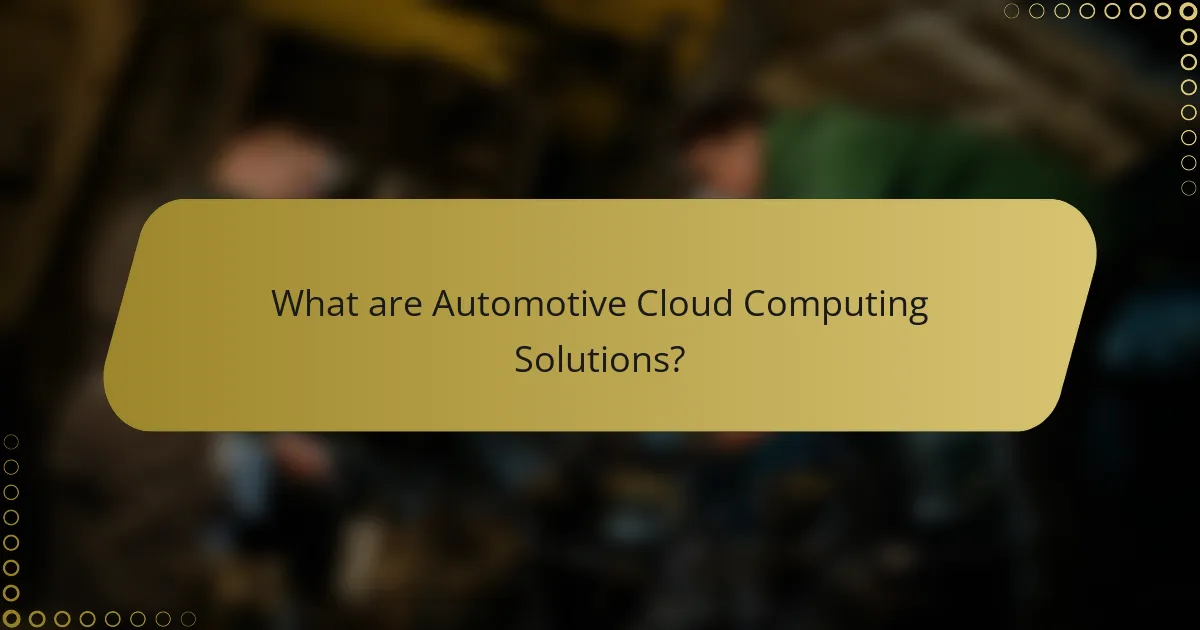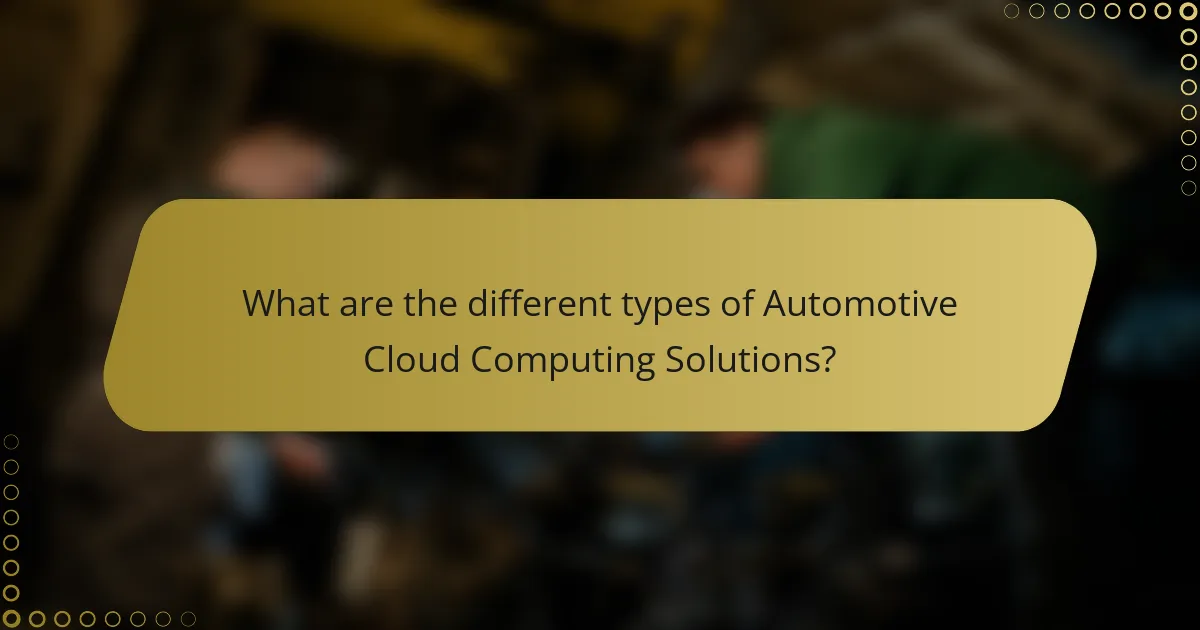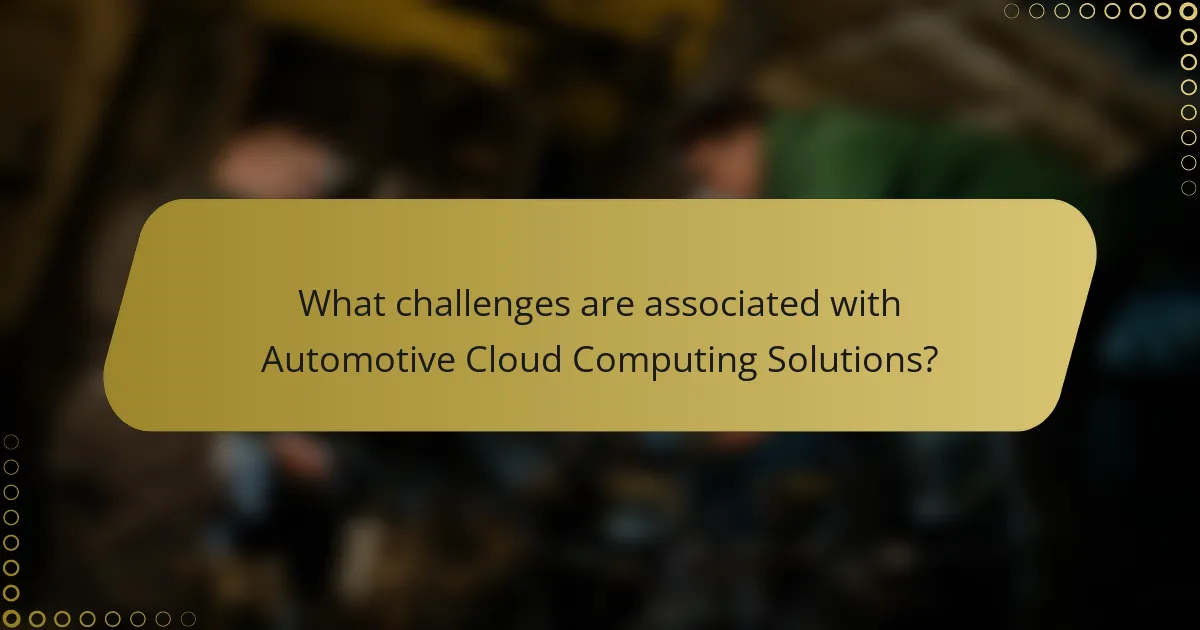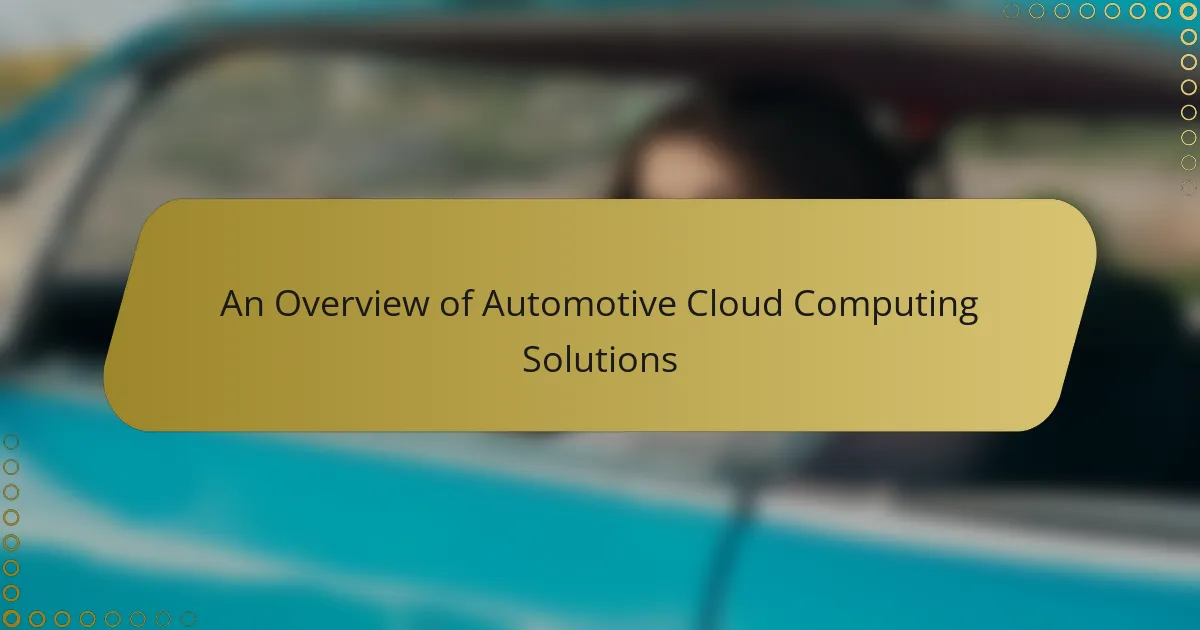Automotive cloud computing solutions are digital platforms designed for data storage, processing, and management within automotive applications, enabling real-time data exchange between vehicles and cloud servers. These solutions support critical functionalities such as vehicle diagnostics, navigation, and infotainment systems, significantly enhancing vehicle performance and user experience. The automotive cloud market is projected to grow substantially, highlighting the industry’s increasing reliance on cloud technologies. However, challenges such as data security, connectivity issues, regulatory compliance, integration with legacy systems, and high implementation costs persist. This overview covers the various types of automotive cloud computing solutions and their roles in modern automotive technology.

What are Automotive Cloud Computing Solutions?
Automotive cloud computing solutions are digital platforms that enable data storage, processing, and management for automotive applications. They facilitate real-time data exchange between vehicles and cloud servers. These solutions support various functionalities, including vehicle diagnostics, navigation, and infotainment systems. Automotive cloud computing enhances vehicle performance and user experience. According to a report by MarketsandMarkets, the automotive cloud market is expected to grow from $11.6 billion in 2020 to $27.6 billion by 2025. This growth underscores the increasing reliance on cloud technologies in the automotive industry.
How do Automotive Cloud Computing Solutions function?
Automotive cloud computing solutions function by utilizing cloud technology to enhance vehicle connectivity and data processing. They enable real-time data exchange between vehicles and cloud servers. This connectivity supports various applications, including navigation, diagnostics, and over-the-air updates. Data collected from vehicles is processed in the cloud, allowing for advanced analytics and machine learning. This enables manufacturers to improve vehicle performance and safety features. Automotive cloud solutions also facilitate remote monitoring and management of fleet vehicles. According to a report by McKinsey, the automotive cloud market is expected to reach $14 billion by 2030, highlighting its growing importance in the industry.
What are the key components of Automotive Cloud Computing Solutions?
Key components of Automotive Cloud Computing Solutions include data storage, data processing, and connectivity. Data storage allows for the secure management of vast amounts of vehicle and user data. Data processing enables real-time analytics and decision-making based on this data. Connectivity ensures seamless communication between vehicles, cloud services, and external systems. Additional components include application development platforms and security protocols. Application development platforms support the creation of automotive applications. Security protocols protect sensitive data from unauthorized access. Together, these components enhance vehicle functionality and user experience.
How do these components interact within Automotive Cloud Computing Solutions?
Automotive Cloud Computing Solutions consist of various components that interact to enhance vehicle functionality. These components include cloud infrastructure, data analytics, connectivity modules, and vehicle systems. The cloud infrastructure stores and processes vast amounts of data collected from vehicles. Data analytics tools analyze this data to provide insights into vehicle performance and driver behavior. Connectivity modules enable real-time communication between vehicles and cloud services. Vehicle systems utilize the processed data to improve features like navigation, safety, and infotainment. Together, these components create a seamless ecosystem that optimizes vehicle operations and enhances user experience.
What are the primary benefits of Automotive Cloud Computing Solutions?
Automotive Cloud Computing Solutions enhance vehicle connectivity and data management. They enable real-time data processing and analysis, improving decision-making for manufacturers and users. These solutions facilitate over-the-air updates, reducing the need for physical service visits. They also support advanced features like predictive maintenance and remote diagnostics. Enhanced security measures protect sensitive data from cyber threats. Additionally, cloud solutions promote collaboration among stakeholders in the automotive ecosystem. Statistics show that companies leveraging cloud solutions can reduce operational costs by up to 30%.
How do Automotive Cloud Computing Solutions enhance vehicle performance?
Automotive Cloud Computing Solutions enhance vehicle performance by enabling real-time data processing and analytics. These solutions facilitate vehicle-to-cloud communication, allowing for continuous monitoring of performance metrics. By analyzing data from various sensors, manufacturers can optimize engine performance and fuel efficiency. Additionally, cloud solutions support over-the-air updates, ensuring vehicles have the latest software enhancements. This leads to improved functionality and safety features. According to a report by McKinsey, connected vehicles can achieve a 10-15% increase in fuel efficiency through data-driven insights. Furthermore, cloud computing allows for predictive maintenance, reducing downtime and enhancing overall vehicle reliability.
What cost savings can be achieved through Automotive Cloud Computing Solutions?
Automotive cloud computing solutions can achieve significant cost savings through reduced infrastructure expenses. These solutions eliminate the need for extensive on-premises hardware. Businesses can benefit from scalability, paying only for the resources they use.
Operational costs are lowered due to improved efficiency and streamlined processes. Cloud solutions enable real-time data access, enhancing decision-making and reducing time delays.
According to a study by Gartner, companies can save up to 30% on IT costs by migrating to cloud-based services. This transition allows for better resource allocation and lower maintenance costs.
Additionally, cloud computing supports over-the-air updates, reducing the need for physical service visits. This can lead to further savings in labor and logistics.

What are the different types of Automotive Cloud Computing Solutions?
There are several types of automotive cloud computing solutions. These solutions include vehicle-to-cloud communication, data analytics platforms, and over-the-air (OTA) update services. Vehicle-to-cloud communication enables real-time data exchange between vehicles and cloud servers. This facilitates features like remote diagnostics and fleet management. Data analytics platforms process large volumes of vehicle data. They can enhance predictive maintenance and improve customer experiences. Over-the-air update services allow manufacturers to deploy software updates remotely. This helps in maintaining vehicle performance and security. Each type of solution plays a crucial role in modern automotive technology. They contribute to enhanced connectivity and smarter vehicles.
How do public, private, and hybrid clouds differ in the automotive context?
Public, private, and hybrid clouds differ significantly in the automotive context. Public clouds offer shared resources and services over the internet. They provide scalability and cost-effectiveness for automotive companies. Private clouds are dedicated to a single organization, ensuring enhanced security and control. This is crucial for managing sensitive automotive data. Hybrid clouds combine both public and private elements. They allow automotive firms to balance scalability with security needs. For example, manufacturers can store sensitive data in private clouds while utilizing public clouds for less critical applications. This flexibility supports various automotive operations, from data analysis to software updates.
What are the advantages of using public cloud solutions for automotive applications?
Public cloud solutions offer scalability, cost-efficiency, and enhanced collaboration for automotive applications. These solutions allow automotive companies to scale resources up or down based on demand. This flexibility helps manage fluctuating workloads effectively. Cost-efficiency is achieved through a pay-as-you-go model, reducing the need for significant upfront investments in infrastructure. Enhanced collaboration occurs as teams can access shared resources and data in real-time from various locations. Furthermore, public cloud platforms often provide advanced security measures and compliance certifications, ensuring data protection. According to a report by McKinsey, companies leveraging cloud technology can improve their operational efficiency by up to 30%. This demonstrates the tangible benefits of adopting public cloud solutions in the automotive sector.
What unique features do private cloud solutions offer for automotive manufacturers?
Private cloud solutions offer automotive manufacturers enhanced data security and control. These solutions allow manufacturers to maintain proprietary data within a secure infrastructure. This minimizes the risk of data breaches, which is critical given the sensitive nature of automotive data.
Private clouds also provide customization options tailored to specific manufacturing needs. This flexibility enables manufacturers to optimize their operations and integrate seamlessly with existing systems. Furthermore, private clouds facilitate compliance with industry regulations, ensuring that manufacturers adhere to standards such as ISO/SAE 21434 for automotive cybersecurity.
Additionally, private cloud solutions support high-performance computing capabilities. This is essential for processing large datasets generated by connected vehicles and advanced manufacturing processes. Manufacturers can leverage these capabilities for real-time analytics and improved decision-making.
Lastly, private clouds enhance collaboration among teams by enabling secure access to shared resources. This fosters innovation and accelerates product development cycles, giving manufacturers a competitive edge in the rapidly evolving automotive market.
What role do edge computing and IoT play in Automotive Cloud Computing Solutions?
Edge computing and IoT are crucial for Automotive Cloud Computing Solutions. Edge computing processes data closer to the source, reducing latency. This is essential for real-time applications like autonomous driving. IoT devices collect vast amounts of data from vehicles, enhancing decision-making. Together, they enable efficient data management and analysis. According to a study by Gartner, edge computing can reduce data transmission costs by up to 50%. This integration improves overall vehicle performance and user experience.
How does edge computing improve data processing in vehicles?
Edge computing enhances data processing in vehicles by enabling real-time data analysis at the source. This reduces latency significantly compared to traditional cloud computing, where data must travel to a distant server for processing. Vehicles equipped with edge computing can analyze data from sensors, cameras, and other systems locally. This local processing allows for quicker decision-making, which is crucial for applications like autonomous driving and safety systems. According to a study by McKinsey, edge computing can reduce data transmission by up to 75%, optimizing bandwidth usage. By processing data closer to where it is generated, vehicles can respond more effectively to changing conditions on the road. This leads to improved performance and safety features in modern vehicles.
What impact does IoT have on the functionality of Automotive Cloud Computing Solutions?
IoT significantly enhances the functionality of Automotive Cloud Computing Solutions. It enables real-time data collection from vehicles, improving decision-making processes. This connectivity allows for better vehicle diagnostics and predictive maintenance. IoT facilitates seamless communication between vehicles and cloud services. Consequently, it supports advanced features like over-the-air updates and remote monitoring. The integration of IoT leads to improved safety and user experience. Research indicates that IoT adoption can reduce operational costs by up to 30%. This demonstrates the tangible benefits that IoT brings to automotive cloud computing.

What challenges are associated with Automotive Cloud Computing Solutions?
Automotive cloud computing solutions face several challenges. Data security is a primary concern due to increased cyber threats. According to a report by McKinsey, 75% of automotive executives cite cybersecurity as a top priority. Connectivity issues can arise because of varying network coverage in different regions. This can impact real-time data processing and vehicle performance. Compliance with regulations is another challenge. Automotive companies must adhere to strict data privacy laws, which can vary by country. Additionally, integration with legacy systems poses difficulties. Many automotive manufacturers still rely on outdated technology that may not easily connect with cloud solutions. Finally, the high costs of implementation can deter smaller companies from adopting these technologies.
What security concerns exist with Automotive Cloud Computing Solutions?
Security concerns with Automotive Cloud Computing Solutions include data breaches, unauthorized access, and inadequate encryption. Data breaches can lead to sensitive information being exposed. Unauthorized access may occur if authentication measures are weak. Inadequate encryption can leave data vulnerable during transmission. Additionally, vehicle hacking poses significant risks, as connected cars can be compromised. Malware attacks can target cloud infrastructure, affecting multiple vehicles. Compliance with regulations like GDPR is essential to protect user data. These concerns highlight the need for robust security measures in automotive cloud computing.
How can automotive companies mitigate data privacy risks?
Automotive companies can mitigate data privacy risks by implementing robust data protection measures. They should adopt encryption technologies to secure sensitive data both in transit and at rest. Regular audits of data access and usage can identify potential vulnerabilities. Training employees on data privacy policies ensures compliance and awareness. Collaborating with cybersecurity experts helps in identifying emerging threats. Adopting privacy by design principles during product development enhances data protection from the outset. Utilizing anonymization techniques for user data reduces the risk of personal identification. Compliance with regulations such as GDPR and CCPA is essential for legal protection.
What are the implications of cybersecurity threats on Automotive Cloud Computing Solutions?
Cybersecurity threats significantly impact Automotive Cloud Computing Solutions. These threats can lead to data breaches, compromising sensitive user information. For example, a successful attack may expose vehicle location data and personal driver details. Additionally, cybersecurity issues can disrupt vehicle operations, potentially leading to safety hazards. The automotive industry relies heavily on cloud computing for real-time data processing. Thus, a cyberattack could impair vehicle-to-everything (V2X) communications. This disruption may hinder traffic management and emergency response systems. Furthermore, the financial implications of cybersecurity threats can be substantial. Companies may face costs related to recovery, legal liabilities, and loss of consumer trust. Overall, the implications of cybersecurity threats necessitate robust security measures in automotive cloud computing.
What are the integration challenges of Automotive Cloud Computing Solutions?
Integration challenges of Automotive Cloud Computing Solutions include data security, interoperability, and latency issues. Data security is crucial as automotive systems handle sensitive information. Breaches can lead to significant risks. Interoperability challenges arise from diverse platforms and technologies used by different manufacturers. Ensuring seamless communication between systems is vital. Latency issues can affect real-time data processing, impacting vehicle performance and safety. The complexity of integrating existing infrastructure with cloud solutions further complicates the integration process. Additionally, regulatory compliance adds another layer of challenge. These factors collectively hinder the effective implementation of cloud computing in the automotive sector.
How can automotive manufacturers effectively integrate cloud solutions with legacy systems?
Automotive manufacturers can effectively integrate cloud solutions with legacy systems by utilizing middleware to bridge the gap. Middleware acts as a translator between cloud applications and legacy systems. It enables data flow and communication without requiring complete system overhauls. Manufacturers should also adopt APIs to facilitate seamless integration. APIs allow different software components to interact efficiently. Incremental migration strategies can be employed to avoid disruption. This approach enables gradual transition to cloud-based solutions while maintaining legacy system functionality. According to a 2021 McKinsey report, 70% of companies that implemented middleware reported improved operational efficiency. This data supports the effectiveness of integrating cloud solutions with existing systems.
What best practices should be followed for seamless integration?
Best practices for seamless integration in automotive cloud computing include establishing clear communication protocols. This ensures all systems can exchange data effectively. Utilizing standardized APIs promotes interoperability between different platforms. Implementing robust security measures protects sensitive data during integration. Regular testing and validation of integrated systems help identify issues early. Continuous monitoring of system performance allows for quick adjustments. Engaging stakeholders throughout the integration process fosters collaboration and alignment. Documenting integration processes aids in future troubleshooting and updates. These practices enhance efficiency and reliability in automotive cloud solutions.
What are the future trends in Automotive Cloud Computing Solutions?
Future trends in automotive cloud computing solutions include increased integration of artificial intelligence and machine learning. These technologies will enhance data processing and analytics capabilities. Real-time data sharing between vehicles and cloud systems will become more prevalent. This will support advanced driver assistance systems and autonomous driving features. Enhanced cybersecurity measures will be crucial to protect sensitive vehicle data. The adoption of edge computing will reduce latency in data transmission. Additionally, vehicle-to-everything (V2X) communication will improve traffic management and safety. Cloud platforms will also enable over-the-air updates for vehicle software. These trends are driven by the growing demand for connected and autonomous vehicles.
How will advancements in AI and machine learning influence Automotive Cloud Computing?
Advancements in AI and machine learning will significantly enhance Automotive Cloud Computing. These technologies will enable real-time data processing and analytics in vehicles. AI algorithms can improve predictive maintenance by analyzing vehicle performance data. Machine learning can optimize routing and navigation by learning from traffic patterns. Enhanced data security protocols will emerge through AI-driven anomaly detection. AI can also facilitate personalized in-car experiences by adapting to user preferences. According to a report by McKinsey, AI applications in automotive could generate up to $1.5 trillion in value by 2030. This demonstrates the substantial impact of AI and machine learning on the automotive cloud landscape.
What emerging technologies are shaping the future of Automotive Cloud Computing Solutions?
Emerging technologies shaping the future of Automotive Cloud Computing Solutions include 5G connectivity, artificial intelligence, and edge computing. 5G enhances data transmission speeds and reduces latency. This allows for real-time communication between vehicles and cloud services. Artificial intelligence enables advanced data analytics and machine learning applications. These applications improve vehicle safety and optimize performance. Edge computing processes data closer to the source, reducing bandwidth usage and improving response times. According to a report by McKinsey, 5G could enable significant advancements in connected vehicle technologies. These technologies collectively enhance the functionality and efficiency of automotive cloud solutions.
What practical tips can automotive companies follow to implement Cloud Computing Solutions successfully?
Automotive companies can implement Cloud Computing Solutions successfully by following several practical tips. First, they should assess their specific needs and objectives related to cloud adoption. This ensures that the chosen solutions align with their business goals. Next, they must select the right cloud service model, whether it’s Infrastructure as a Service (IaaS), Platform as a Service (PaaS), or Software as a Service (SaaS). Each model has distinct advantages that can cater to different operational requirements.
Furthermore, companies should prioritize data security and compliance with regulations. Implementing robust security measures protects sensitive information and builds customer trust. It is also essential to invest in employee training. This helps staff understand cloud technologies and maximizes the benefits of the implemented solutions.
Additionally, automotive companies should consider partnering with experienced cloud service providers. These partnerships can offer valuable insights and support during the implementation process. Regularly evaluating cloud performance is crucial. This allows companies to make necessary adjustments and improvements over time.
Finally, establishing a clear migration strategy is vital. A well-structured plan minimizes disruptions during the transition to cloud services. By following these tips, automotive companies can enhance their cloud computing implementation efforts effectively.
Automotive cloud computing solutions are digital platforms that facilitate data storage, processing, and management for automotive applications, enabling real-time data exchange between vehicles and cloud servers. This article provides a comprehensive overview of the functionalities, key components, and benefits of these solutions, including enhanced vehicle performance, cost savings, and improved user experience. It also explores different types of automotive cloud solutions, the role of edge computing and IoT, challenges related to cybersecurity and integration, and future trends shaping the industry. By understanding these aspects, stakeholders can better navigate the evolving landscape of automotive technology.
